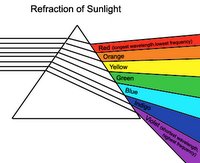What is a rainbow?
A rainbow is an arc of light separated into bands of color (parallel stripes) that appear when the Sun's rays are refracted and reflected by drops of mist or rain. The colors of the rainbow are red, orange, yellow, green, blue, indigo, and violet. These are the full spectrum of colors that make up the sun's white light. Thus, rainbow is a multicolored arc of light in sky.
Why is a rainbow coloured?
First to understand why rainbow have colors or how they get their colors, you will need to know that white light is made up of a spectrum of colors that exhibit the characteristics of a wave. To be more specific, white light ( e.g. the Sun’s light) is made up of wavelengths of different colors of light. This phenomenon can be explained and was demonstrated by mathematician and scientist Sir Isaac Newton 1642-1727 by letting a beam of sunlight (white light ) passing through a prism. He showed that the sunlight is composed of several different colors, (Red, Orange, Yellow, Green, Blue, Indigo and Violet in that order respectively) that human eye doesn’t see separately.
The colors are produced by a phenomenon called dispersion. When white light passes through a prism, it scatters (disperse) the different colors of light according to their wavelength or frequencies, showing a continuous band of colors (called a spectrum) as it travels from one medium (e.g. prism) to another (e.g. air). These different colors of light have all slightly different directions and so display each color components of white light. Thus, the angle of bending is different for different wavelengths of light. This band of colors appears in the same pattern as the colors of a rainbow. This means, all the different colors of light (red, orange, yellow, green, blue, indigo and violet) combine to give you what is called white light. These colors, based on their wavelength, are arranged in the order shown above when they are being scattered. The longest wavelengths of light are on the red end of the spectrum and the shortest wavelengths are on the violet end of the spectrum.
How rainbows are formed/what causes a rainbow?
The principle explained above can be applied to how rainbow is formed in the sky. When there are water droplets in the atmosphere for instance, during or immediately following a shower of rain, there will be thousands of these tiny droplets (raindrops) floating around in the air. When light from the Sun encounters a water droplet (spherical in shape), it penetrates the outer boundary of the droplet. As it enters, the light is bent (refracted) and scattered (disperse) into a continuous band of colors (a rainbow of colors). These colors are then reflected from off the back of the drop again as they pass through the front of the drop once more, thus being bent (refracted) still some more. These continuous band of colors as explained above, is due to the fact that the angle of bending is different for different wavelengths of light. This explains the reason for the appearance of the band of colors which is due to their wavelength. There you will always see the colors of a rainbow in the following order of colors; Red, Orange, Yellow, Green, Blue, Indigo and Violet. Red is refracted the least, and violet the most. The other colors are found between these two. Blue light has a shorter wavelength than that of red light because it as a longer wavelength and thus, is refracted more. Therefore resulting a blue light to be located in the inner section of the rainbow and red light to be located in the outer section of the rainbow. This same principle explains the reasons for the order in which the different colors of light appears in a rainbow.
A rainbow is always directly opposite the sun from the observer. That is, the rainbow appears in front of the observer, whose back is to the sun. Therefore the rainbow that the observer will see in the sky will caused by thousands of water droplets acting like thousands of tiny prisms resulting the different component colors of white light (sunlight) to be displayed. Each falling water droplet (raindrops) flashing its colors to the observer for just an instant, before another drop takes its place letting the rainbow appearance remain constant to the observer. The rainbow's location will appear different for observers at different locations, but it is always directly opposite the sun. This means another observer will not see the rainbow if the sun is not behind that person. So, it will all depend on the angle of the Sun in the sky in relation to where you are, providing that enough water droplets are in the atmosphere for you to see this effect. This will not work if the sun is directly over head. Looking on the diagrams you will see why rainbows are only seen when the sun is low in the sky, usually in the late afternoon. It is also important to note that the rainbow is light reflected to the eye at an angle of 42 degrees to the original ray of sunlight. This implies that when we see a rainbow at the 42 degree angle, it is measured from each observers eye thus therefore, no two persons will see exactly the same rainbow.
(link)


%20passing%20through%20a%20water%20droplet.jpg)
No comments:
Post a Comment